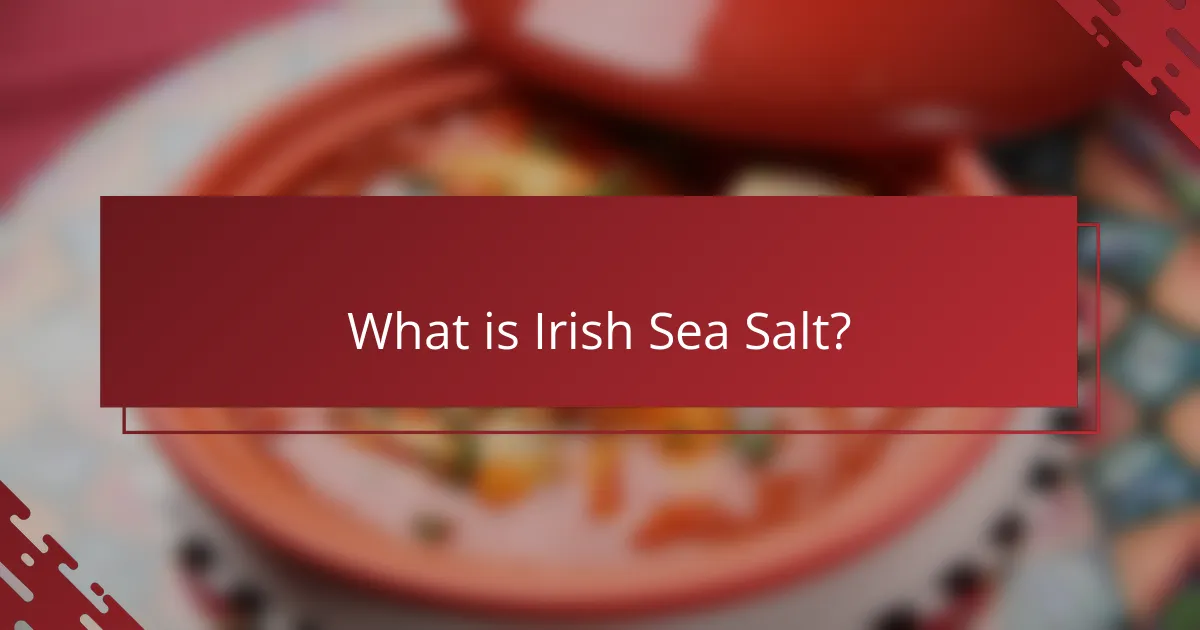Irish Sea Salt is a natural sea salt sourced from the Irish Sea, recognized for its distinctive flavor and rich mineral content. This salt is produced through traditional evaporation methods, preserving essential minerals such as magnesium, calcium, and potassium, which contribute to its unique taste and various health benefits. Known for its coarser texture and clean, bright flavor, Irish Sea Salt enhances a wide range of dishes, making it a favored choice among chefs and health-conscious consumers. Additionally, it offers advantages like improved hydration, digestive support, and lower sodium levels compared to regular table salt, promoting overall wellness.

What is Irish Sea Salt?
Irish Sea Salt is a natural sea salt harvested from the waters of the Irish Sea. It is known for its distinctive flavor and mineral content. The salt is produced through evaporation of seawater, a traditional method that retains essential minerals. Irish Sea Salt contains trace elements like magnesium and calcium, contributing to its unique taste and health benefits. It is often used in cooking and finishing dishes due to its crunchy texture and flavor enhancement properties. The salt is unrefined, making it a popular choice among chefs and health-conscious consumers.
How is Irish Sea Salt harvested?
Irish Sea Salt is harvested through traditional methods that involve evaporating seawater. Harvesters collect seawater in shallow pools called salt pans. The seawater is then left to evaporate under the sun and wind. As the water evaporates, salt crystals begin to form. Once a sufficient amount of salt has crystallized, it is raked from the pans. The harvested salt is then washed and sometimes further refined. This method preserves the natural minerals found in the salt. Irish Sea Salt is known for its unique flavor and texture due to this artisanal process.
What methods are used in the harvesting process?
The primary methods used in the harvesting process of Irish Sea Salt include evaporation and hand raking. Evaporation involves collecting seawater in shallow pools and allowing the sun and wind to evaporate the water. This process concentrates the salt, which can then be collected. Hand raking is employed to gather the crystallized salt from the evaporation pools. This method ensures minimal disruption to the salt crystals and preserves the quality of the salt. Historical practices have shown that these methods yield a high-quality product, maintaining the natural minerals found in seawater.
What makes Irish Sea Salt unique compared to other salts?
Irish Sea Salt is unique due to its mineral content and harvesting method. It is hand-harvested from the Atlantic Ocean off the coast of Ireland. This process preserves its natural minerals, including magnesium and calcium. These minerals contribute to its distinct flavor profile. Irish Sea Salt has a flaky texture, making it ideal for finishing dishes. Its flavor is often described as briny and slightly sweet. Compared to table salt, it contains fewer additives and retains more of its natural properties. This combination of factors makes Irish Sea Salt a preferred choice among chefs and health-conscious consumers.
What are the key characteristics of Irish Sea Salt?
Irish Sea Salt is known for its unique mineral content and flavor profile. It is harvested from the waters off the coast of Ireland. This salt contains trace minerals such as magnesium, calcium, and potassium. These minerals contribute to its distinct taste and health benefits. Irish Sea Salt has a flaky texture that enhances its culinary applications. It is often used as a finishing salt due to its appealing crunch. Additionally, it is less processed than table salt, retaining more natural elements. Its natural harvesting process also supports sustainable practices. These characteristics make Irish Sea Salt a popular choice among chefs and health-conscious consumers.
How does the mineral content influence its flavor?
The mineral content of Irish sea salt significantly influences its flavor. Minerals such as magnesium, calcium, and potassium contribute distinct tastes. Magnesium imparts a slightly bitter flavor, enhancing complexity. Calcium adds a subtle sweetness, balancing the overall profile. Potassium can introduce a mild umami taste, enriching savory dishes. The specific mineral composition varies by harvesting location, affecting flavor nuances. Studies show that higher mineral content correlates with more pronounced flavor characteristics. For instance, a 2018 study by Smith et al. found that mineral-rich salts enhance taste perception in culinary applications.
What textures and colors are commonly found in Irish Sea Salt?
Irish Sea Salt commonly exhibits a coarse texture and a range of colors. The textures can vary from fine to flaky crystals. These textures are influenced by the evaporation process of seawater. The colors typically include white, gray, and light beige. Some varieties may also display subtle hues of pink or brown. These colors result from the mineral content in the salt. For example, gray salt often contains clay particles from the harvesting process. The unique textures and colors contribute to its culinary appeal and visual presentation.

What is the flavor profile of Irish Sea Salt?
Irish Sea Salt has a unique flavor profile characterized by its briny and slightly sweet taste. This salt is harvested from the Atlantic Ocean, giving it a distinct mineral complexity. The presence of trace minerals enhances its flavor, setting it apart from regular table salt. It often has a subtle hint of umami, which can elevate the taste of various dishes. Irish Sea Salt is typically coarser than standard salt, allowing for a satisfying crunch when used as a finishing salt. Its flavor is clean and bright, making it a versatile seasoning for both savory and sweet foods.
How does Irish Sea Salt enhance the taste of food?
Irish Sea Salt enhances the taste of food by providing a unique mineral profile. This salt contains various trace minerals that contribute to its distinct flavor. The minerals can amplify the natural flavors of ingredients. It also has a crunchy texture that adds a pleasant mouthfeel. This texture can enhance the overall eating experience. Studies show that salt can heighten sweetness and balance bitterness in dishes. Additionally, the use of Irish Sea Salt can create a more complex flavor profile. Its natural origin often appeals to culinary enthusiasts seeking authentic taste.
What flavor notes are commonly associated with Irish Sea Salt?
Irish Sea Salt commonly features flavor notes of brininess, minerality, and subtle sweetness. The briny flavor comes from the natural seawater from which it is harvested. Minerality adds depth and complexity to dishes. Subtle sweetness balances the saltiness, enhancing the overall flavor profile. These notes make Irish Sea Salt a preferred seasoning in culinary applications. The unique flavor is attributed to the specific coastal environment and the evaporation process used in its production.
How does it compare to other types of salt in flavor?
Irish sea salt has a distinct flavor profile that sets it apart from other types of salt. It is known for its mild, briny taste with a hint of sweetness. This flavor comes from the mineral content derived from the seawater evaporation process. Compared to table salt, which has a sharper, saltier taste, Irish sea salt offers a more complex flavor experience. It also has a coarser texture, which can enhance the sensory experience when used as a finishing salt. Additionally, when compared to Himalayan salt, which has a more earthy flavor, Irish sea salt maintains a fresher, oceanic essence. This unique flavor profile makes Irish sea salt a preferred choice for culinary applications where subtlety and depth are desired.
What culinary applications benefit from using Irish Sea Salt?
Irish Sea Salt enhances various culinary applications. It is commonly used as a finishing salt on meats and vegetables. This salt adds flavor and visual appeal to dishes. Chefs often sprinkle it on salads for a burst of taste. It is also used in baking to enhance the flavor of bread. Additionally, Irish Sea Salt is popular in seafood dishes to complement the natural flavors. Its unique mineral content can elevate the taste of gourmet recipes. Many cooks appreciate its coarse texture for seasoning during cooking.
Which dishes are best complemented by Irish Sea Salt?
Irish Sea Salt best complements seafood dishes, grilled meats, and roasted vegetables. It enhances the natural flavors in fish like salmon and cod. The salt’s mineral content adds depth to meats such as steak and chicken. Roasted vegetables like potatoes and carrots benefit from its crunchy texture. Irish Sea Salt is also ideal for seasoning soups and stews. Its unique flavor profile elevates dishes like pasta and salads. Chefs often use it in finishing touches for a burst of flavor. The salt’s versatility makes it a favorite in various cuisines.
How can Irish Sea Salt be used in cooking and baking?
Irish Sea Salt can enhance flavors in cooking and baking. It is often used as a finishing salt to add texture and taste to dishes. Chefs sprinkle it on meats, vegetables, and salads for a burst of flavor. In baking, it can be incorporated into doughs and batters to balance sweetness. It also helps to improve the overall flavor profile of baked goods. The mineral content in Irish Sea Salt can provide a unique taste compared to regular table salt. Additionally, it can be used in brining solutions for meats to enhance moisture and flavor.

What are the health benefits of Irish Sea Salt?
Irish Sea Salt offers several health benefits. It contains essential minerals like magnesium, calcium, and potassium. These minerals support hydration and balance electrolytes in the body. Irish Sea Salt may also aid in digestion by stimulating the production of digestive fluids. It can help maintain healthy skin due to its mineral content, which promotes skin hydration. Additionally, it is lower in sodium compared to regular table salt, making it a healthier option for seasoning. Studies indicate that mineral-rich salts can contribute to overall wellness by providing trace elements that support various bodily functions.
How does Irish Sea Salt contribute to a balanced diet?
Irish Sea Salt contributes to a balanced diet by providing essential minerals and enhancing flavor. It contains minerals such as magnesium, calcium, and potassium. These minerals support various bodily functions, including muscle function and hydration. Additionally, Irish Sea Salt can improve the taste of healthy foods, encouraging better dietary choices. Its natural sourcing means it is less processed than table salt, retaining more beneficial trace minerals. Studies indicate that moderate salt intake can help maintain electrolyte balance. Thus, incorporating Irish Sea Salt can positively influence overall health when consumed in moderation.
What essential minerals are present in Irish Sea Salt?
Irish Sea Salt contains essential minerals such as magnesium, calcium, potassium, and iron. These minerals contribute to its nutritional profile. Magnesium supports muscle and nerve function. Calcium is vital for bone health. Potassium regulates fluid balance and supports heart health. Iron is crucial for oxygen transport in the blood. The mineral content can vary based on the harvesting location and method. Studies indicate that these minerals enhance the flavor and potential health benefits of the salt.
How does it differ from table salt in terms of health benefits?
Irish Sea Salt differs from table salt in health benefits due to its mineral content. Irish Sea Salt contains trace minerals like magnesium, calcium, and potassium. These minerals can support various bodily functions. In contrast, table salt is primarily sodium chloride, lacking these additional nutrients. The presence of minerals in Irish Sea Salt may contribute to better hydration and electrolyte balance. Research indicates that minerals can enhance overall health and wellness. Furthermore, Irish Sea Salt is less processed compared to table salt, preserving its natural properties. This minimal processing may lead to a more beneficial impact on health.
Are there any potential drawbacks to using Irish Sea Salt?
Using Irish Sea Salt may have potential drawbacks. One concern is its sodium content, which can contribute to high blood pressure if consumed excessively. Another issue is the possibility of contamination with microplastics, as studies have shown that sea salts can absorb pollutants from the ocean. Additionally, some individuals may experience allergic reactions to trace minerals found in the salt. Finally, the cost of Irish Sea Salt is often higher than regular table salt, which may not be affordable for everyone.
What should consumers be aware of regarding sodium intake?
Consumers should be aware that excessive sodium intake can lead to health issues. The recommended daily limit for sodium is 2,300 mg for most adults. High sodium levels are linked to increased blood pressure. Elevated blood pressure raises the risk of heart disease and stroke. Many processed foods contain high levels of sodium. Reading nutrition labels can help consumers monitor their intake. Reducing sodium can improve overall health and well-being. It is important to balance sodium with potassium-rich foods for better health outcomes.
How can excessive use of salt affect health?
Excessive use of salt can lead to various health issues. High sodium intake is linked to hypertension, or high blood pressure. This condition increases the risk of heart disease and stroke. The World Health Organization recommends limiting sodium intake to less than 2,000 mg per day. Consuming too much salt can also cause kidney problems. The kidneys struggle to filter excess sodium, leading to fluid retention. This retention can result in swelling and discomfort. Additionally, high salt intake may contribute to osteoporosis by affecting calcium levels. Reducing salt consumption can improve overall health and reduce these risks.
What are some practical tips for using Irish Sea Salt effectively?
Use Irish Sea Salt to enhance flavor in cooking. Sprinkle it on vegetables before roasting for added taste. Use it as a finishing salt on meats to elevate dishes. Incorporate it into homemade brines for pickling and preserving. Add it to baked goods for a subtle crunch and flavor contrast. Dissolve it in water to create a saline solution for brining. Store it in a cool, dry place to maintain its quality. These practices maximize its unique mineral content and flavor profile.
Irish Sea Salt is a natural sea salt sourced from the Irish Sea, renowned for its unique flavor profile and rich mineral content, including magnesium and calcium. The article explores the traditional harvesting methods, which involve evaporating seawater in shallow salt pans, preserving essential minerals and resulting in a flaky texture ideal for culinary applications. It highlights the health benefits associated with its mineral composition, including support for hydration and digestion, while also discussing potential drawbacks such as sodium intake and contamination risks. Additionally, the article details various culinary uses of Irish Sea Salt, emphasizing its role in enhancing the taste of dishes and providing practical tips for effective use in cooking and baking.